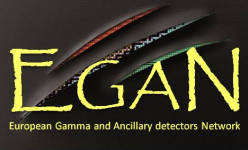Speaker
Corinne Louchart
(CEA Saclay, Service de Physique nucléaire)
Description
Radioactive nuclei provide unique opportunities to investigate the nuclear-structure properties as a function of isospin. This work is focused on the region of neutron-rich nuclei at about N=40 and the development of collectivity towards N=50. 68Ni presents a large E(2+) and a small transition probability B(E2), signs of a shell closure. However, recent experiments point towards a rapid onset of collectivity and deformed shapes for Cr, Fe, Zn and Ge isotopes. Along the Iron chain, E(2+) becomes very low and the B(E2) value increases suddenly near N=40. For the Zinc isotopes, the E(2+) continuously decreases from N=38 to N=44. Coulomb-excitation measurements of 74-80Zn at REX-ISOLDE indicate a maximum of collectivity for 74Zn [VdW].
This work aims at measuring the lifetime of low-lying states in the neutron-rich Zn isotopes and investigating how the residual interaction between the valence nucleons polarizes the 68Ni core. As the electromagnetic transition rates and quadrupole moments are sensitive to these effects, they are ideal observables to constrain theoretical nuclear structure models. Refined lifetime measurement of the first excited states in 72,74Zn have been performed through a recoil-distance Doppler shift method (RDDS) in order to obtain a direct measurement of B(E2) values. These informations couple with previous Coulomb excitation experiment allows an estimation of the 74Zn quadrupole moment.
The experiment has been performed at Legnaro in Italy, with the AGATA demonstrator (composed of 4 triple clusters) and the PRISMA spectrometer. A 76Ge beam at 577 MeV impinging on a 238U target has been used to produce the Zinc isotopes from deep-inelastic scattering.
First results for the measured transition probabilities and comparison to theoretical calculations will be shown.
[VdW] J. Van de Walle et al., Phys. Rev. C 79 014309 (2009)
Primary author
Corinne Louchart
(CEA Saclay, Service de Physique nucléaire)

